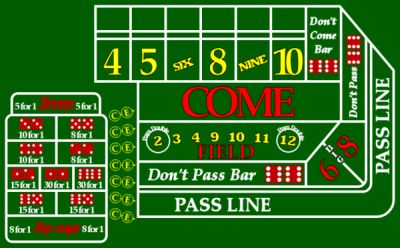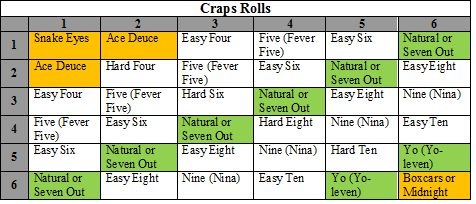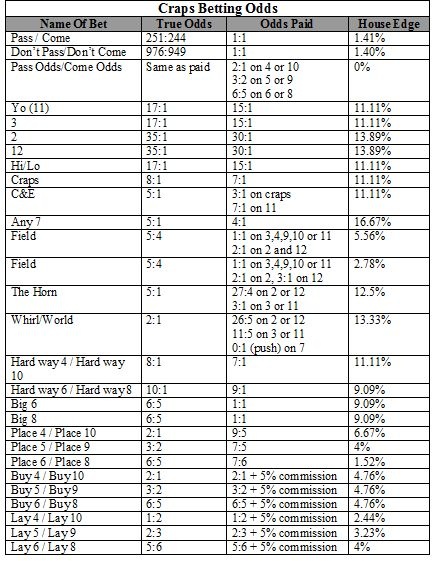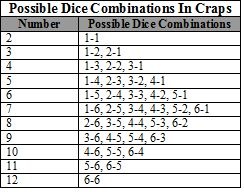Award-winning Casinos:
Best Casino for High Rollers: Royal Vegas
Best Casino for Canadians: Maple Casino
Best Casino for US players: WinPalace
What Is Craps And How Is Craps Played
Thursday, 10. February 2023
 Craps is a very popular and exciting dice game played with a pair of dice in which bets are placed on the outcome of a roll of the dice or on a series of rolls. Craps can be played online, at the casino and even on the street (street craps is also known as shooting or rolling dice). Craps is a game where players wager against the bank except in the case of street craps where players wager against one another.
Craps is a very popular and exciting dice game played with a pair of dice in which bets are placed on the outcome of a roll of the dice or on a series of rolls. Craps can be played online, at the casino and even on the street (street craps is also known as shooting or rolling dice). Craps is a game where players wager against the bank except in the case of street craps where players wager against one another.
Whether played on the street or in the casino, a game of craps is quite easy to find, all that is required is that you follow the roar of the crowd. Craps tables tend to be amongst the most exciting tables at the casino, especially when the tables are hot.
The History of Craps
Modern Craps is basically a simplified version of the Old English dice game Hazard. The true origins of Craps are somewhat cloudy but it is agreed that the game’s history reaches back to the Crusades and was later influenced by the French.
What was later to become the modern day American version of Craps was brought to New Orleans by the Louisiana landowner, politician and gambler Bernard Xavier Philippe. There was a flaw intrinsic in the version introduced by Bernard in which players could have an unfair advantage using fixed dice and exploiting the way players were able to bet either with or against the thrower. The “Don’t Pass” betting option, introduced by John Winn, addressed this flaw and the result is the game of Craps that is still played to this day.
Street craps is a game generally played by the African American community. Street craps is often played by rolling the dice against a curb or stoop. Street craps is known simply as “shooting dice.”
A type of street craps was popular amongst American soldiers during World War II. An army blanket was often used as the dice shooting surface and the dice were not rolled against a board or curb of any type. Since the dice were not rolled against any backboard of any kind, this game gave rise to a number of presumed methods of dice control, the most common of which was known as the “army blanket roll.”
How To Play Craps
The game of Craps is played by a number of players at the same time, all betting against the casino, or bank. Each participating player takes turns rolling a pair of dice. The player rolling the dice is known as the “shooter.” Players have a number of betting options from which to choose, all of which are made by placing their chips in the appropriate section on the Craps table.
The shooter is required to have a bet either on the “Pass” line (also known as a “Win” or “Right” bet) or on the “Don’t Pass’ line (also known as a “Don’t Win” or “Wrong” bet). Craps is a game played in rounds and these bets are wagers on the outcome of the round. The position of “shooter” will commonly switch at the end of the round or when the current “shooter” rolls a 7. The position of “shooter” moves clockwise around the Craps table. Before a player makes their first roll as “shooter”, the stickman will give them a number of dice from which the new shooter must select two.
Each round of Craps is made up of two parts; “come-out” and “point”. At the opening of a round, the shooter will make one or a number of “come-out” rolls. A come-out roll of either 7 or 11 is known as a “natural” and wins resulting in a payout for all of the Pass line bets. A come-out roll of 2, 3 or 12 is known as “craps” and loses resulting in a loss for all of the Pass line bets. A come-out roll resulting in any of the remaining numbers (known as the point numbers), including the 4, 5, 6, 8, 9 and 10, establishes what is known as the “point”. The point is the number that must be rolled again before rolling a 7. Once a point number is rolled, the dealer will turn the button to its “On” side and place the button over the point number on the Craps board thus signifying the beginning of the “point” part of the round. In the event that the shooter rolls a 7 before they manage to roll the “point” number, the Pass line bets lose and the round concludes.
The Layout Of The Craps Table
 Craps is played on specially marked, felt covered Craps tables. The Craps table displays all of the possible betting variations and, in most casinos, Craps tables are split in half. Each side of the table is a mirror image of the other with the center bets located at the center of the table. The tables are double sided simply to allow for convenience as the shooter may roll the dice from either end of the Craps table and also to allow for more players to participate in the action.
Craps is played on specially marked, felt covered Craps tables. The Craps table displays all of the possible betting variations and, in most casinos, Craps tables are split in half. Each side of the table is a mirror image of the other with the center bets located at the center of the table. The tables are double sided simply to allow for convenience as the shooter may roll the dice from either end of the Craps table and also to allow for more players to participate in the action.
Each Craps table at the casino will be run by up to 4 casino workers: the boxman, two base dealers and the stickman. The boxman’s job is to keep an eye on the chips, watch the dealers and color out players. The base dealers will stand on each side of the boxman and it is their job to collect and payout bets. The stickman will stand across the table from the boxman and it is their job to take the bets at the center of the table (yo, horn, craps, etc.), announce the results of the shooter’s rolls, collect the dice after the roll (with the stick) and make it known to the base dealers to pay the bets from the center of the table.
How To Join In On A Game Of Craps
When wishing to join in a game of craps at the casino, players must first check to see whether the dealer’s “On” button is resting on any of the point numbers. If the button is on then the table is currently in the “point” part of the round and most casinos will allow players to make a Pass line bet. All single and multi proposition bets can be placed in either part of the round. Dealers collect losing bets and payout the winning bets in between rolls of the dice. Once the dealer has settled up, players can place new bets. Players may continue to place bets until the stickman presents the shooter with the dice. After the shooter is given the dice, no more bets may be placed.
Rolling The Dice In Craps
When rolling the dice in a game of Craps, the shooter must roll the dice with one hand and the dice must strike the far wall of the table. In the event a die jumps the table wall during a roll, the shooter may either choose another die from the stickman or can request to use the same die that popped off the table once it has passed the inspection of the boxman.
Each possible outcome of a roll of the dice in Craps has a nickname associated with it and it is important that one be familiar with them before playing:

Having nicknames for the different rolls adds a little excitement to the game and the nicknames can vary somewhat from casino to casino. Dice rolls resulting in 4, 6, 8, and 10 can be known as “hard” or “easy”. The roll is called “hard” when it made with a double; for example, a “hard” eight is one made up of a roll of two 4’s. The roll is called “easy” when it is made with any other combination of dice; for example, an “easy” eight can be made up of a roll of either 5 and 3 or 6 and 2.
Roll of 2: A roll of 2 is most commonly known as “Snake Eyes”, this is presumably because the single dots showing on each of the dice together resembles a pair of eyes. During the come-out, a roll of 2 is also known as “two craps two” since the Pass line bet is lost and a bet on craps wins. A roll of 2 during a point roll is sometimes known as “Aces; Double the Field” in order to encourage subsequent bets. A roll of two may also be known as “Loose Deuce”.
Roll of 3: A roll of 3 is most commonly called “Three Craps Three” when hit during the come-out roll. At any other roll other than the come-out roll, a roll of 3 will be called “Three Ace Deuce, come away single” meaning that the come bet is lost and any Field bets are to be paid single.
Roll of 4: A roll of 4 is also known sometimes as “Little Joe from Kokomo”. This term has its origins in the way African Americans from the South pronounce the number “four” (“fo”). Not what one may call “politically correct” but it is what it is.
Roll of 5: A roll of 5 is often known as “No Field Five” because the number “5” is not present on the Field and, therefore, not paid out in a Field bet.
Roll of 6: A roll of 6 is also known as “Jimmy Hicks” or “Jimmy Hicks From The Sticks”, presumably because of the fact that it rhymes with the number “6”. If a winning roll of 6 is made then it will often be called “666 winner 6” followed by “came easy” or “came hard” depending on whether the roll was a hard or easy 6.
Roll of 7: A roll of 7 comprised of a 6 and 1 is often known as “Up Pops the Devil” or “Six Ace”. When the shooter rolls a 7 during the come-out phase, it is called “Seven, Front Line Winner”. When the shooter rolls a 7 during the point phase, it will often be called “7 out 7” or simply “7 out.”
Roll of 8: A roll of a hard 8 has a number of different nicknames, the majority of which are of a sexual nature: “Mom and Dad”, “Ozzie and Harriet”, “Square Pair” and “Eight The Hard.”
Roll of 9: A roll of 9 is most commonly known as “Centerfield Nine” because the number “9” appears in the center of the betting area, also known as the “Field.” A roll of 9 made up of a 4 and a 5 is called a “Railroad Nine” in the casinos of Atlantic City. It is also known as a “Jesse James” because Jesse James was reportedly killed by a .45 caliber pistol.
Roll of 10: A roll of 10 the hard way is also known as “Hard Ten” and a “Woman’s Best Friend”…more sexual double entendres.
Roll of 11: A roll of 11 is known as “Yo’Leven” or simply “Yo”. This nickname is used because “eleven” can sometimes be heard as “seven” and use of the expletive “Yo” helps to make it clear.
Roll of 12 A roll of 12 is most commonly known as “Boxcars” or “Midnight”. At Craps tables that pay triple the field on a roll of 12, the stickman will generally call out “Triple!”.
Different Craps Bets
Line Bets
Before making their first roll as the “shooter”, a player must place either a Pass line bet or a Don’t Pass bet. There are certain casinos that will require that all participating players place a minimum Pass line bet or Don’t Pass bet regardless of whether they are the shooter.
Pass Line Bet: The Pass line bet is the most basic bet in craps and is simply a bet that the shooter will roll their point number. If the shooter rolls a come-out roll of 7 or 11 then the bet is immediately won. If the shooter rolls a come-out roll of 2, 3 or 12 then they “crap out and the Pass line bet is lost. If any number other than those listed above is rolled then that number becomes known as the “point”. If the “point” number is rolled before the 7 then the Pass line bet wins. If the 7 is rolled before the “point” number then the Pass line bet is lost. The Pass line bet is an even money bet.
Don’t Pass Line Bet: The Don’t Pass line bet is a bet on the shooter rolling a 7 before hitting their “point number.” A simple way of looking at the Don’t Pass line bet is that it is the opposite of the Pass Line bet. With a Don’t Pass line bet, if the shooter’s come-out roll is 2 or 3 then the Don’t Pass line bet wins and if the come-out roll is a 7 or 11 then the Don’t Pass line bet loses. A roll of 12 will generally result in a draw depending on the casino; either way, the player cannot lose on a roll of 12 with a Don’t Pass line bet. If the shooter establishes a “point” number and rolls the “point” number again then the Don’t Pass line bet loses. While a perfectly acceptable bet in terms of the rules of Craps, Don’t Pass line bets are not commonly made for the simple reason that it is considered by most as poor taste to bet against the shooter and it is often known, for this reason, as “playing the dark side”.
Pass Odds: As mentioned above, when the shooter rolls a 4, 5, 6, 8, or 10, they set the “point” number. When this is the case, most casinos will allow players that made a Pass line bet to make an additional bet of from 1 to 5 times the Pass line bet. This bet is placed behind the Pass line bet. This additional bet wins when the “point” number is rolled before 7. This bet pays winners at true odds:
4 or 10: When a 4 or 10 is the “point” number, it pays 2:1.
5 or 9: When a 5 or 9 is the “point” number, it pays 3:2.
6 or 8: When a 6 or 8 is the “point” number, it pays 6:5.
There are certain casinos that will offer what is called “3-4-5X Odds”. This simply means that players may bet:
When a 4 or 10 is rolled: 3 times the Pass line bet.
When a 5 or 9 is rolled: 4 times the Pass line bet.
When a 6 or 8 is rolled: 5 times the Pass line bet.
The great thing about Odds bets is that they payout in accordance with their true odds. Making a maximum Pass Odds bet over a minimum Pass line bet will often offer players the lowest house edge at the casino. However, don’t shed a tear for the casinos just yet; since Pass Odds bets cannot be made independently of a Pass line bet, the casino is still taking their piece.
Don’t Pass Odds: If the player is feeling cheeky and decides to “play the dark side” and make a Don’t Pass line bet then they may also make a Don’t Pass Odds bet. The Don’t Pass Odds bet is to the Don’t Pass line bet as the Pass Odds bet is to the Pass line bet. If the shooter establishes a “point” number then players having made a Don’t Pass line bet may make a Don’t Pass Odds bet. This is a bet that the shooter will roll a 7 before their “point” number. The Don’t Pass Odds bet pays true odds:
4 or 10: When a 4 or 10 is the “point” number, it pays 1:2.
5 or 9: When a 5 or 9 is the “point” number, it pays 2:3.
6 or 8: When a 6 or 8 is the “point” number, it pays 5:6.
Come Bet: The Come bet is similar to the Pass line bet and is played over the course of two rounds. The primary difference between the two is that a Come bet is a wager made on the first point number of the shooter’s following roll, irrespective of the round. When a player makes a Come bet, the following throw of the dice is treated in the same way that a come-out roll as regards Pass Line bets. The roll can win the bet, lose the bet or establish a “point” number in the same way. If the shooter rolls a 7 or 11 in the first round then the Come bet wins. If the shooter rolls a 2, 3, or 12 in the first round then the Come bet loses. If; however, the shooter rolls a 4, 5, 6, 7, 9 or 10 then the dealer will move the player’s Come bet to the corresponding number’s box on the Craps table. This number is what is known as the Come bet point and the player, if they wish, may make a Come Odds bet along with their Come bet. If the shooter rolls the Come bet point number before the 7 in the second round then the Come bet wins as well as any associated Come Odds bet. If the shooter rolls the 7 before the Come bet point number in the second round then the Come bet loses as well as any associated Come Odds bet.
The best way to explain the Come bet is through an example: Let us say that the player makes a Come bet and the shooter rolls a 4. The player’s come bet is picked up and moved over to the 4 section of the Craps table. At this point, the player may include a Come Odds bet along with the Come bet. Now, the player’s only concern is that the shooter roll a 4 before a 7…no other number is of any significance to the player. Players may have up to 7 Come bets running simultaneously.
It is important to note that Come Odds bets are automatically considered inactive during a come-out roll whereas the Come bet is always active. This becomes interesting when the shooter rolls a Come point number or 7 during the come-out roll. If the shooter rolls the Come point number in their come-out roll while the player has a Come bet with an associated Come Odds bet then the Come bet is paid but the Come Odds bet is simply returned to the player since the Come Odds bet is considered inactive during come-out rolls. If the shooter rolls a7 in their come-out roll while the player has a Come bet with an associated Come Odds bet then the Come bet is lost but the Come Odds bet is simply returned to the player since the Come Odds bet is considered inactive during come-out rolls. While the Come Odds bets are automatically considered inactive during the come-out roll, the player may request from the dealer that the Come Odds bets remain active during come-out rolls and the dealer will place and “On” button on the player’s Come Odds bet.
Don’t Come Bet: The Don’t Come bet is just like the Come bet, just rocking the dark side, so to speak. As with the Come bet, the Don’t Come bet is made over two rounds. If the shooter rolls a 2 or a 3 in the first round then the Don’t Come bet wins. If the shooter rolls a 7 or 11 in the first round then the Don’t Come bet loses. A standoff is reached in the event that the shooter rolls a 12 and the player may either revoke their bet or let it ride. If the shooter rolls a 4, 5, 6, 8, 9 or a 10 then the rolled number becomes the Don’t Come point number and the Don’t Come bet is moved to the corresponding number’s box on the Craps table. The Don’t Come bet will then win if, in the second round, the shooter rolls a 7 before the Don’t Come point number.
Single Roll Bets
Single Roll bets are also known as proposition bets and are made on a single roll of the die. Most of the Single Roll bets are “Service Bets” and can be found at the center of the Craps table.
The Single Roll bets are as follows:
2 (Snake Eyes, Aces): This bet wins if the shooter rolls a 2.
3 (Ace Deuce): This bet wins if the shooter rolls a 3.
11 (Yo, Yo’leven): This bet wins if the shooter rolls an 11.
12 (Midnight, Boxcars): This bet wins if the shooter rolls a 12.
2 or 12 (Hi-Lo): This bet wins if the shooter rolls either a 2 or a 12. The stickman will place a Hi-Lo bet on the line that divides the 2 and 12 bet on the Craps table.
Any Craps (Three-Way): This bet wins if the shooter rolls either a 2, 3 or a 12.
C & E: The C & E bet is a combination bet where the player places half of their wager on Craps and the other half on 11 (Yo’leven).
Any Seven (Big Red): This bet wins if the shooter rolls a 7.
The Horn: The Horn bet is a combination bet where an equal bet is placed on the 2, 3, 11 and 12 for the shooter’s next roll. The Horn bet is essentially four individual bets and its payout will be determined by which of the numbers was rolled minus three betting units placed on the other three numbers. A common variation on the Horn bet is the Horn High bet. The Horn High bet is the same as a Horn bet just with an additional number. For example, a Horn High Ten bet would be a Horn bet with an additional betting unit placed on the 10.
Whirl (World): A Whirl bet is a combination of the Horn Bet and the Any Seven bet.
On The Hop: The On The Hop bet is a bet that a certain combination of the dice will be rolled by the shooter on their next roll. A player betting 3 and 1 on the hop are wagering that the shooter’s next roll will be made up of one die of 3 and another die of 1. This bet will pay 15:1. The odds change when betting on the shooter rolling doubles on the hop. For example, a bet of 5 and 5 on the hop will pay 35:1. The true odds of these On The Hop bets are 17:1 and 35:1, respectively, or a house edge of 11.11% and 13.89% respectively.
Field: The Field bet is a bet that the shooter will roll either a 2, 3, 4, 9, 10, 11 or 12 on their next roll of the dice. Generally speaking, a Field bet will payout differently depending upon the number that is rolled. The Field bet will payout 1:1 if a 3, 4, 9, 10 or 11 is rolled and 2:1 or 3:1 if either the 2 or 12 is rolled. Field bets are known as “Service Bets” because the player places the Field bet themselves on the Field bet section of the Craps table as opposed to a dealer or stickman placing it for them.
Multi Roll Bets:
Multi Roll bets are a type of bet whose outcome is not necessarily determined by a single roll of the dice. When making a Multi Roll bet, you might find yourself in a situation where the shooter rolls their point number before the outcome of the Multi Roll bet has been determined. In this instance, the Multi Roll Bet is considered as “not working” until the shooter has established a new point number, unless of course the player calls the bet as “working”.
The Multi Roll bets are as follows:
Hard Way: A Hard Way bet is a bet that the shooter will roll either a 4, 6, 8 or 10 the hard way before they roll a 7 or the same number the Easy Way.
Easy Way: An Easy Way bet is a bet that the shooter will roll either a 4, 6, 8 or 10 the easy way before they roll a 7.
Big 6 and Big 8: A Big 6 bet is a bet that the shooter will roll a 6 before the 7 and the Big 8 bet is a bet that the shooter will roll an 8 before the 7. This bet pays even money and is not commonly played since an individual bet on either the 6 or the 8 will pay 7:6.
Place and Buy: With Place and Buy bets, players have the opportunity to buy or place any of the possible point numbers (4, 5, 6, 8, 9 and 10) by simply placing their total bet in the Come area of the Craps table and instructing the dealer what size bet to place on what numbers. Place and Buy bets are bets that whatever point number selected will be rolled by the shooter before the 7. Both of these bets are considered working bets and will continue to payout to the player each time the shooter rolls the selected Buy point or Place point number. The difference between Place bets and Buy bets is simply in the way that the casino takes their cut. Place bets will payout at slightly below true odds and Buy bets will payout at true odds; however, the casino will charge a 5% commission on the amount of the bet.
Lay: The Lay bet is the exact opposite of a Buy bet. With a Lay bet, the player is wagering that the shooter will roll a 7 before the laid number. As with a Buy bet, Lay bets enjoy true odds with a 5% commission charged by the casino.
Fire Bets
Some casinos will allow a Fire bet to be made before the shooter begins rolling. A Fire bet is basically a bet that the shooter will hit a hot streak. Fire bets are long shot bets that payout big. As the shooter hits point numbers in a streak, the numbers are marked on the table with a little chip with a fire symbol. Fire bets begin paying out on the shooters fourth point number roll in a streak. The fourth point number rolled by the shooter pays 24:1, the fifth point number pays 249:1 and the sixth point number pays 999:1.
Craps Betting Odds
The following table lists the True Odds, Odds Paid and the House Edge of each Craps bet. It is important to note that while the payout ratios can vary from casino to casino, the ones listed below are the most common payout ratios at US casinos.

The odds of the payouts in Craps is determined by the probability that each of the possible dice combinations have of being rolled. The table below shows all of the possible combination of dice that can make up each number.

Join the William Hill Casino for the best Craps action online.
Related Articles
News & Promotions »
- Knuckle Up And Get In On The All Slots Casino’s Fight Club
- Claim Your $1,250 No Deposit Bonus At The Maple Casino
- Incredible Bonus Coupons Available This Week At The Club World Casino
- The BC Lottery Corp Considers Move Into The Realm Of Mobile Gaming
- Mr. Cashback Pays A Visit To Playtech Powered Online Casinos
- Rival Gaming Announces Release Of Summer Ease Video Slot
- Poker In The Park V Event Looking To Break Mahjong Record
- Canadian Online Slots Players Can’t Get Enough Of The Royal Vegas Casino
- Bilateral Agreement Signed Between Denmark And Alderney
- It’s All About The Green This Weekend At The Mr Green Casino With 10 Free Spins

Casinophiles Poll:
 |
|
|||||||||||||||||||
Articles »
- Dice Control In Casino Craps
- The Labouchére Craps Betting System
- The Fibonacci Craps Strategy
- Online Casinos Accepting NETELLER
- Online Casinos Accepting PayPal
- What Are Slot Machines And How Do Slot Machines Work
- What Is Pai Gow Poker And How Is Pai Gow Poker Played
- What Is Video Poker And How Is Video Poker Played
- What Is Craps And How Is Craps Played
- What Is Keno And How Is Keno Played
Casino Video:
Vist Website
Read Review
